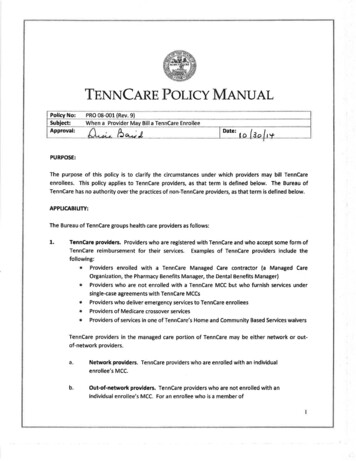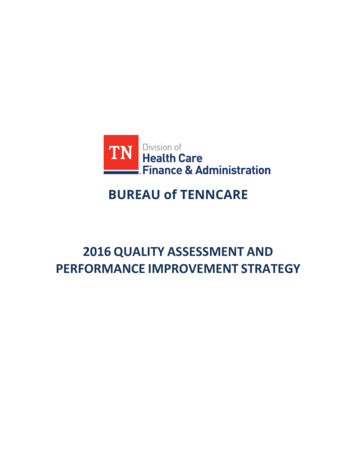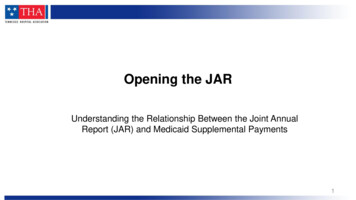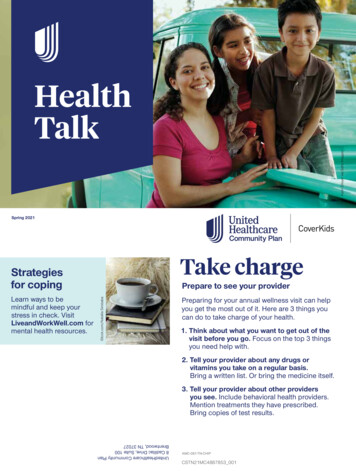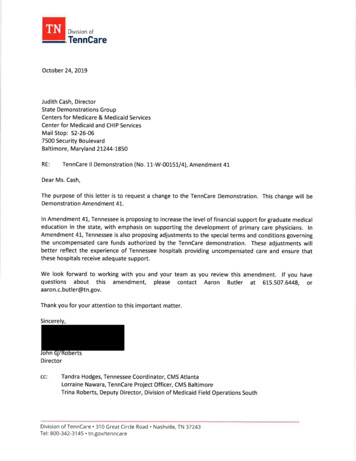
Transcription
Division of TennCareTennCare II DemonstrationProject No. 11-W-00151/4Amendment 41October 24, 2019
Table of ContentsSection I: Description of the Amendment.1Section II: Expected Impact on Budget Neutrality .3Section III: Expected Impact on CHIP Allotment Neutrality .3Section IV: Modifications to the Evaluation Design .3Section V: Demonstration of Public Notice and Input .3Appendices:Appendix A: Proposed Edits to the TennCare DemonstrationAppendix B: Documentation of Public NoticeAppendix C: Public Comments Receivedii
Amendment 41 to the TennCare II DemonstrationThe TennCare demonstration has existed since 1994 as one of the oldest and most comprehensiveMedicaid managed care demonstrations in the nation. The most recent extension of the TennCaredemonstration in 2016 established two new funds through which the State reimburses qualifyinghospitals for unreimbursed costs realized as a result of Medicaid shortfall and charity care. The Virtual DSH Fund totals up to 463,996,853 annually and can be used to pay for Medicaidshortfall and charity care costs.The Uncompensated Care Fund for Charity Care (“Charity Care Fund”) totals up to 252,845,886annually and can be used to pay for charity care costs.The state began implementing the Virtual DSH and Charity Care Funds on July 1, 2018.The TennCare demonstration also governs the State’s financial support for graduate medical education(GME) in Tennessee. GME is supported by a separate fund totaling 50 million annually. This amounthas been unchanged since the inception of the TennCare II demonstration.In Amendment 41, Tennessee proposes to amend the Special Terms and Conditions (STCs) governingpayments from its two uncompensated care funds. These proposed changes reflect the actualexperience of Tennessee healthcare providers furnishing uncompensated care and will help to ensurethat TennCare has adequate flexibility to provide support to these providers. This includes updates tothe methodology used to distribute monies from these two funds to hospitals. The State also proposesto increase the level of support provided for GME through the TennCare demonstration.I.Description of the AmendmentAmendment 41 consists of these three components:1. Adjust the funding amount in TennCare’s GME Fund.2. Adjust the maximum funding amounts in TennCare’s Charity Care and Virtual DSH Funds.3. Update the distribution methodology for the Charity Care and Virtual DSH Funds.Each of these proposed changes is discussed below.Adjust the Funding Amount in the GME FundTennCare’s current GME fund of 50 million annually has been in place since the inception of theTennCare II demonstration. Under the terms of the TennCare demonstration, TennCare makes GMEpayments to the four medical universities in Tennessee that operate graduate physician medical1
education programs.1 These payments are for use by those universities to fund the graduate medicaleducation activities of associated teaching hospitals or clinics, and are allocated each year based on eachuniversity’s relative number of primary care residencies.The State proposes to increase the funding amount in the TennCare GME fund in order to increasesupport for graduate medical education in Tennessee and the development of primary care physicians inTennessee generally. The proposed increase in the GME fund will consist of an amount to bedetermined each year by applying the applicable year’s FMAP to an annual increase of 3,750,000 instate funding. This additional GME funding will be allocated based on the extent to which the fouruniversities increase the number of primary care residents above their historical baseline levels. TheState’s proposed edits to the STCs governing the TennCare GME fund are illustrated in Appendix A.Adjust the Maximum Funding Amounts in the Charity Care Fund and Virtual DSHThe Charity Care Fund and the Virtual DSH Fund are the two funds through which TennCare reimbursesTennessee hospitals for the cost of providing uncompensated care. The initial amount of the CharityCare Fund was established when the current TennCare STCs were approved on December 16, 2016.2However, these STCs also contemplate that the State may seek a demonstration amendment to adjustthis amount, if the State provides a data analysis produced by an independent entity of the actualuncompensated care incurred by Medicaid providers in the state. The State has procured the services ofan independent accounting firm (Myers and Stauffer, LC) to conduct a study of net unreimbursed charitycare costs incurred by Tennessee providers, using a methodology patterned on the approach used byCMS to set the initial charity care amount in 2016. Using data from the CMS Medicare Cost Report Form2552-10 and the Tennessee Department of Health’s Joint Annual Report of Hospitals, the studyconcluded that net unreimbursed charity care costs for reporting periods ending in calendar year 2016were 589,886,294. (See attached report.) This amount exceeds the 252,845,886 annual limit forpayments from the Charity Care Fund. Accordingly, the State requests that the annual limit onpayments from the Charity Care Fund be adjusted by 337,040,408. This adjustment wouldappropriately recognize the charity care costs incurred by Medicaid providers in Tennessee and helpensure the state has flexibility to provide support for Tennessee hospitals.In addition to unreimbursed charity care costs, the same independent study estimates that Medicaidproviders in Tennessee experienced 508,936,029 in net unreimbursed Medicaid shortfall costs forreporting periods ending in calendar year 2016. (See attached report.) This amount is 44,939,176more than the current cap on the Virtual DSH Fund specified in the STCs of the TennCare demonstration.Because these costs cannot be paid from the Charity Care Fund, the state requests that the Virtual DSHFund be increased by 44,939,176. The State notes that when the Virtual DSH fund was established in2016, the amount of the fund was based on the TennCare demonstration’s existing DSH adjustmentamount, and that this amount has not been changed since Demonstration Year 10 (2011-2012). A small1Universities that receive TennCare GME payments are East Tennessee State University, Meharry Medical College,the University of Tennessee at Memphis, and Vanderbilt University.2CMS subsequently made a technical correction to this amount on October 23, 2018.2
adjustment in the size of the Virtual DSH Fund would allow the state to ensure that Medicaid providersin Tennessee do not experience excessive Medicaid shortfall costs.Update the Distribution Methodology for the Charity Care Fund and Virtual DSHAdjusting the amounts of the Charity Care Fund and Virtual DSH Fund will also entail revisions to theState’s approved distribution methodology for these funds in order to account for the distribution of theadditional dollars. In addition, the State proposes the creation of a new sub-pool within the Charity CareFund, to be known as the Uncompensated Charity and Self-Pay Sub-Pool, to address unreimbursedcharity and self-pay costs that are otherwise unaddressed within the current system. The State’sproposed edits to the uncompensated care distribution methodology are illustrated in Appendix A.II.Expected Impact on Budget NeutralityImplementation of Amendment 41 will increase the state’s capacity to reimburse qualifying hospitals forcosts incurred in providing uncompensated care by 381,979,584 per year. It is projected that actualdemonstration expenditures will increase by approximately 11 million per year in additional GMEexpenditures, and approximately 144 million per year in additional uncompensated care payments.Attached is an updated overview of the demonstration’s finances that reflects this adjustment.III.Expected Impact on CHIP Allotment NeutralityThis amendment will not result in any changes to Tennessee’s CHIP allotment neutrality.IV.Modifications to the Evaluation DesignThe state does not anticipate modifying the demonstration evaluation design based on these changes.V.Demonstration of Public Notice and InputThe state has used multiple mechanisms for notifying the public about this amendment and for solicitingpublic input on the amendment. These public notice and input procedures are informed by—andcomply with—the requirements specified at 42 CFR § 431.408.Public NoticeThe State’s public notice and comment period began on September 9, 2019, and lasted through October11, 2019. During this time, a comprehensive description of the amendment to be submitted to CMS wasmade available for public review and comment on an amendment-specific webpage on the TennCarewebsite. An abbreviated public notice—which included a summary description of Amendment 41; the3
locations, dates, and times of two public hearings; and a link to the full public notice on the State’samendment-specific webpage—was published in the newspapers of widest circulation in Tennesseecities with a population of 50,000 or more. TennCare disseminated information about the proposedamendment, including a link to the relevant webpage, via its social media (i.e., Twitter, Facebook).TennCare also notified the members of the Tennessee General Assembly of Amendment 41 via anelectronically transmitted letter.The state held two public hearings to seek public comment on Amendment 41. The first hearing tookplace on September 25, 2019, at 11:30 a.m. at the Bellevue branch of the Nashville Public Library, 720Baugh Road in Nashville. The second public hearing took place on September 26, 2019, at 2:00 p.m.Central Time at the TennCare Building, 310 Great Circle Road in Nashville. Telephonic access to theSeptember 26 hearing (in the TennCare Building) was offered to individuals who were unable to attendin person and who notified the state of their desire to participate by telephone. Members of the publicalso had the option to submit comments throughout the notice period by mail and/or email.Documentation of the state’s public notice process is included as Appendix BPublic CommentsThe state received one comment in response to its public notice on Amendment 41. This commenterwas supportive of the proposed increase in funding for GME, and in particular the state’s proposal touse increased GME funding to support the development of primary care physicians in order to increaseaccess to care for Tennesseans. This commenter noted the importance of primary care in helpingindividuals navigate the healthcare system, as well as disease prevention, health promotion, and earlydetection of illnesses and other conditions, and noted that Tennessee is experiencing shortages ofprimary care providers, dental providers, and mental health services providers. The state appreciatesthe commenter’s support for the GME component of Amendment 41.The commenter also expressed appreciation to the state for acquiring more recent data on hospitaluncompensated care costs and supported the state’s proposal to adjust the amount of the Charity CareFund by 252.8 million. With regard to the state’s proposal to adjust the amount of the Virtual DSHFund by 45 million, the commenter recommended that the state consider increasing the size of theCharity Care Fund by an additional 45 million, rather than adjusting the Virtual DSH Fund by thisamount. The state thanks the commenter for this recommendation. After consideration, the state haselected not to modify the amendment based on this recommendation.Under the current terms and conditions governing TennCare’s uncompensated care funds, the VirtualDSH Fund is the only fund that can be used to compensate hospitals for Medicaid shortfall costs. To theextent that the proposed 45 million adjustment represents a recognition of excess Medicaid shortfallcosts, the Virtual DSH fund is the appropriate fund to adjust in order to adequately meet the needsbeing experienced by Tennessee hospitals.The comment received by the state on Amendment 41 is attached as Appendix C.4
Appendix AProposed Edits to the TennCare Demonstration
CENTERS FOR MEDICARE & MEDICAID SERVICESEXPENDITURE AUTHORITYNUMBER:No. 11-W-00151/4 Title XIXTITLE:TennCare II Medicaid Section 1115 DemonstrationAWARDEE:Tennessee Department of Finance and AdministrationUnder the authority of Section 1115(a)(2) of the Social Security Act (the Act), expenditures madeby the state for the items identified below, which are not otherwise included as expenditures underSection 1903, shall, for the period of this demonstration extension, be regarded as expendituresunder the state’s Medicaid title XIX state plan.The following expenditure authorities shall enable Tennessee to implement the Medicaid Section1115 demonstration (TennCare II):5.Indirect Payment of Graduate Medical Education.Expenditures, up to 50 million in total computable expenditures for eachdemonstration year, for payments to universities that operate graduate physicianmedical education programs, which are restricted for use by those universities tofund graduate medical education activities of associated teaching hospitals or clinics. Anadditional amount determined by applying the applicable year’s FMAP to the annualstate share of 3,750,000 will be distributed to the same group of universities for thepurpose of increasing the number of primary care residents in training.1
CENTERS FOR MEDICARE & MEDICAID SERVICESSPECIAL TERMS AND CONDITIONS (STCs)X.GENERAL FINANCIAL REQUIREMENTS58.Extent of Federal Financial Participation for the Demonstration.Subject to CMS approval of the source(s) of the non-Federal share offunding (see Section X, paragraph 59, Sources of Non-Federal Share), CMSshall provide FFP at the applicable Federal matching rates for thedemonstration as a whole as outlined below, subject to the budget neutralitylimits described in Section XI of these STCs. When referenced, actual cashdisbursements is intended to signify that certified public expendituresmay not be used to establish expenditures for these pools.d.Graduate Medical Education (GME) Pool. Actual cashdisbursements, up to 50 million in total computable expenditures,plus an additional amount determined by applying the applicableyear’s FMAP to the annual state share of 3,750,000, for eachdemonstration year, paid by the state from a supplemental pool topay for GME costs in accordance with the pool distributionmethodology described below. CMS will only approve FFP forsupplemental pool payments made in accordance with the followingapproved pool distribution methodology, authorized by thedemonstration’s expenditure authorities. Should CMS promulgatenew regulations, the TennCare GME program must come intocompliance in accordance with the effective date of the newregulations.GME Pool Methodology: GME Pool payments will be made tothe following medical universities that operate graduate physicianmedical education programs. These payments are restricted for use bythose universities to fund graduate medical education activities ofassociated teaching hospitals or clinics: East Tennessee StateUniversity, Meharry Medical College, University of Tennessee atMemphis, and Vanderbilt University. The annual base GME Poolfunds of 50M total (state share plus federal match) will be allocatedbased on the annual ratio derived by dividing each hospital’s averageof its Primary Care Position Allocation and its Total Filled PositionsAllocation by the aggregate of the medical hospitals’ averages. ThePrimary Care Position Allocation is computed by taking eachhospital’s total number of primary care residents in years 1through 4 of residency and dividing it by the total of all primarycare residents in the medical hospitals in years 1 through 4 ofresidency. The Total Filled Positions Allocation is computed bytaking each hospital’s total number of residents in years 1 through 4of residency and dividing it by the total of the medical hospitals’number of residents in years 1 through 4 of residency. This annual2
ratio is applied to the total GME Pool funding to be allocated. Theadditional GME funding that is determined by applying theapplicable year’s FMAP to the annual state share of 3,750,000 willbe allocated based on the annual ratio derived by dividing eachuniversity’s total primary care residents over the historical baselineset by TennCare into the total of every university’s total primary careresidents over the total historical baseline. The annual GME Poolfunds will be disbursed quarterly. The state must make thesepayments directly to the universities, and not through any third partyor intermediary.61.Permissible Uncompensated Care Payments. Funds for uncompensatedcare payments under the demonstration may be used for health care coststhat would be within the definition of medical assistance in section 1905(a)of the Act. For purposes of Tennessee uncompensated care, beginning July1, 2018 there are two funds for which different types of uncompensated caremay be paid under the demonstration.a.Virtual DSH Fund. The virtual DSH fund includes the state’sDSH adjustment amount in budget neutrality described in Table 8below, and subsumes the statutory DSH allotment provided in section1923 of the Act. Funds in virtual DSH (which includes statutoryDSH) will be used to reimburse hospitals for uncompensated care(consistent with the definition of uncompensated care in 42 CFR447.299) and can serve the same purposes of a DSH allotmentprovided under the statute. The state is authorized for the DSHAdjustment (federal share) set forth in Table 8; the total computableamount will depend on the State’s FMAP in each DY. The DSHAdjustment (federal share) will be adjusted using a methodologyconsistent with the changes to the federal DSH allotments in otherstates under section 1923(f)(7) of the Act for federal fiscal year 2019and thereafter, to the extent those changes to the federal DSHallotment are in effect for other states.b.Uncompensated Care Fund for Charity Care. Funds in theUncompensated Care Fund for Charity Care will be used for healthcare costs that are incurred by the state, hospitals, or health careclinics to furnish uncompensated medical care as charity care forlow-income individuals that are uninsured. The costs must beincurred pursuant to a charity care program for individuals withincomes up to at least 200 percent of the federal poverty level thatadheres to the principles of the Healthcare Financial ManagementAssociation.The state is authorized for 252,845,886 totalcomputable for the Uncompensated Care Fund for Charity Care inDY 17 and each DY thereafter. The state is authorized for 589,886,294 total computable for the Uncompensated Care Fund forCharity Care in DY 18 and each DY thereafter.3
69.Budget Neutrality Ceiling. The following describes the method forcalculating the budget neutrality expenditure limit:d.The DSH adjustment is based upon Tennessee’s DSH allotment for1992 and was calculated in accordance with current law. Table 8gives the DSH adjustments for DY 1 through DY 19, and shows bothtotal computable and Federal share. These totals reflect changes tothe calculation of DSH allotments resulting from the MedicarePrescription Drug, Improvement, and Modernization Act of 2003,and the temporary increase in DSH allotments provided underSection 5002 of the American Recovery and Reinvestment Act of2009. Beginning in DY 10, the DSH adjustment was held constantwhile awaiting to determine the impact of Medicaid expansion underthe Affordable Care Act on uncompensated care and DSH.Beginning with DY 15, the DSH adjustment is considered “VirtualDSH” for purposes of paying for uncompensated care due toMedicaid shortfall under the demonstration. The federal share of theDSH adjustment is based on the state’s federal medical assistancepercentages (FMAP) for the applicable demonstration year.Table 8DSH Adjustments and Virtual DSHDSH AdjustmentDSH Adjustment(total computable)(Federal share) 413,700,907 268,409,148DY 1 479,893,052 310,106,890DY 2 479,893,052 310,538,794DY 3 479,893,052 308,091,339DY 4 479,356,649 305,451,928DY 5 479,657,638 305,451,928DY 6 485,299,094 311,270,839DY 7 488,969,517 319,052,610DY 8 470,369,327 309,408,043DY 9 463,996,853 305,451,928DY 10 463,996,853 305,451,928DY 11 463,996,853 305,451,928DY 12 463,996,853 305,451,928DY 13 463,996,853 305,451,928DY 14DY 15-DY 19 DY 17 463,996,853Based on ApplicableVirtual DSHFMAP 508,936,029Based on ApplicableDY 18 - DY 19FMAPVirtual DSH4
ATTACHMENT HDISTRIBUTION METHODOLOGY FOR UNCOMPENSATED CARE PAYMENTSThe supplemental pool framework effective in SFY 2018-2019 2019-2020 (Demonstration Year17 18) includes two pools with defined caps: A “Virtual DSH” pool not to exceed 463,996,853 508,936,029 total computableannually. An Uncompensated Care Fund for Charity Care (the Charity Care pool) not to exceed 252,845,886 589,886,294 total computable annually.Virtual DSH PoolThe State proposes to make the following payments within the Virtual DSH Pool in each SFY: Critical Access Hospital Sub-pool – 15 million Statutory DSH Method Sub-pool – approximately 81 million (fixed annual federalallocation of 53.1 million, total varies with FMAP) Children’s Safety Net Sub-pool - 25 million 28.6 million Other Essential Acute Sub-pool - 43.5 million 60.7 million Safety Net Sub-pool - 30.5 million 36.3 million Psychiatric Facilities Sub-pool - 1.5 million 2,173,144 Public Hospital Costs Sub-Pool – up to 240 millionSome hospitals may be eligible to receive supplemental payments to be distributed from morethan one sub-pool. In such cases, as payment from one sub-pool is calculated, the amount of thatpayment will be taken into account as additional sequential sub-pool payments are calculated toensure that duplication and overpayment do not occur.Critical Access Hospital Sub-pool – 15 millionQualifications -- To qualify for payment as a Critical Access Hospital, a hospital must meet thefollowing criteria: The hospital is an acute care hospital located and licensed in the state of Tennessee, The hospital has been designated a Critical Access Hospital by the Tennessee Departmentof Health, The hospital contracts with a managed care organization participating in TennCare, The hospital contracts with TennCare Select, The hospital provides accurate and timely admission, discharge, and transfer data toTennCare, and The hospital participates in the State’s payment reform initiatives, including episodes ofcare, as appropriate.Reimbursement -- TennCare will pay to Critical Access Hospitals under the following terms.Inpatient Services -- Payment for uncompensated TennCare inpatient services costs that arefurnished by Critical Access Hospitals will be made quarterly with interim per diem rates
with year-end cost settlements. Using the as-filed Medicare Cost Reports for the most recentyear available, interim per diem rates for TennCare inpatient services will be determined withconsideration of payments for TennCare services to hospitals by managed care organizationsand any special payments to hospitals.The inpatient interim per diem rate is calculated as follows: Values for Inpatient Routine and Ancillary Service Medicaid costs and total Medicaidinpatient days are obtained from Worksheet D-1 of the most recent as-filed MedicareCost Report (lines 39, 48 and 9 respectively). From this information, a Medicaid cost perdiem can be calculated.The “Interim MCO Payment” for the CAH is determined by the payments for inpatientservices (excluding any TennCare Quarterly Interim Settlement Reimbursements) asreported on Worksheet E-3 (line 41).These payments are divided by the number of reported Medicaid days for the quarter todetermine the per diem amount the CAH received as payment from the TennCaremanaged care organization.The inpatient interim per diem rate for the CAH is the difference between the totalallowed Medicaid cost per diem and the per diem amount paid to the hospital by theMCO.Inpatient Critical Access Hospital services will not include more than 15 acute inpatient beds.An exception to the 15 bed requirement is made for swing bed hospitals. Critical AccessHospitals are allowed to have up to 25 inpatient beds that can be used interchangeably foracute or Skilled Nursing Facility (SNF) level of care, provided that not more than 15 beds areused at any one time for acute care.Outpatient Services -- Payment for uncompensated TennCare outpatient services costs thatare furnished by Critical Access Hospitals will be made quarterly based on a percentage ofcharges with year-end cost settlements.Using the as filed Medicare Cost Reports for the most recent year available, interim rates forTennCare outpatient services will be determined as a percentage of charges, withconsideration for payments of TennCare services to hospitals by managed care organizationsand any special payments to hospitals.The interim outpatient rate will be calculated as follows: First, total Medicaid Outpatient costs and total Medicaid Outpatient charges arereferenced from the MCR from Worksheet E-3; (line 2 and line 12, respectively).The MCO outpatient payments to the CAH (excluding any TennCare Interim QuarterlyPayments) are divided by the CAH’s total Outpatient Medicaid Charges to derive anMCO Payment to Charge ratio.This MCO Payment to Charge Ratio is then compared to the CAH’s calculated overallOutpatient Cost to Charge Ratio. The difference between the Outpatient CCR and theMCO Payment to Charge ratio equals the Interim Supplemental Reimbursement Rate forthe CAH for Outpatient Services.
Total Payment – Each hospital’s total payment will be calculated as follows:1. Each hospital’s interim inpatient per diem is multiplied by their Medicaid inpatient days.2. Each hospital’s interim outpatient rate (percentage) is multiplied by their Medicaidoutpatient charges.3. The products of steps 1 and 2 are added together to derive an amount for each hospital.Cost Settlements -- Cost settlements are determined from provider submitted Medicare costreports that include the title XIX schedules based on 100 percent (100%) of TennCare reasonablecosts. The term “reasonable costs” is defined for this purpose as total reimbursable costs underMedicare principles of cost reimbursement for Critical Access Hospitals.New Designations of Critical Access Hospitals -- For new hospitals that qualify after July 1,2018, the state will begin reimbursement at the rates established by this part on the first day ofthe calendar month after notification to the Bureau of TennCare by the hospital of its CriticalAccess Hospital designation. At that time, interim rates will be established according to this partand the designation will be confirmed with the Tennessee Department of Health.Audit Trail and Audit Requirements -- Each CAH is required to maintain adequate financial andstatistical records which are accurate and in sufficient detail to substantiate the cost datareported. These records must be retained for a period of not less than 5 years from the date of thesubmission of the Joint Annual Report and the related Medicare Cost Report, and the provider isrequired to make such records available upon demand to representatives of the Bureau ofTennCare or the United States Department of Health and Human Services. All hospital costreports and Joint Annual Reports are subject to audit at any time by Federal and state auditors,including the Comptroller of the Treasury and the Bureau of TennCare, or their designatedrepresentative.Statutory DSH Method Sub-pool – 53,100,000 divided by FMAP (approximately 81million)In addition to federal requirements for DSH participation, hospitals in Tennessee must meet thefollowing eligibility criteria: The hospital must have at least one of the following: (i) at least 13.5% or more of theirtotal adjusted days covered by TennCare; or (ii) 9.5% or more of the total adjusted daysare covered by TennCare and the number of adjusted days for the hospital is higher than theaverage number of TennCare Adjusted Days; or (iii) be a children’s hospital defined as afree standing hospital that serves primarily children under 18 years of age and is identifiedto the public as a children’s hospital with a separate emergency department staffed andequipped to provide emergency services to pediatric patients.The hospital must have unreimbursed Medicaid cost, unreimbursed self-pay, and/or charitycare cost.The hospital contracts with a managed care organization participating in TennCare.The hospital contracts with TennCare Select.The hospital provides accurate and timely admission, discharge, and transfer data toTennCare.The hospital participates in the State’s payment reform initiatives, including episodes of
care, as appropriate.This sub-pool is the only sub-pool within the Virtual DSH pool for which all participatinghospitals are required to meet the DSH requirements in Section 1923 of the Social Security Actincluding the requirement to provide OB services. Participation in all other Virtual DSH subpools is not contingent on meeting the requirement to provide OB services.In Tennessee, multiple facilities may be included on a single license and the facilities that share alicense are all included on a single Medicare cost report. Hospitals that share a Medicare costreport are identified separately in the State’s Joint Annual Report data and the JAR data for thosefacilities would be grouped together so that the DSH audit values would align correctly. TheState proposes to distribute the funds within the Sub-pool using the methodology outlined i
TennCare’s current GME fund of 50 million annually has been in place since the inception of the TennCare II demonstration. . primary care providers, dental providers, and mental health services providers. The state appreciates the c

